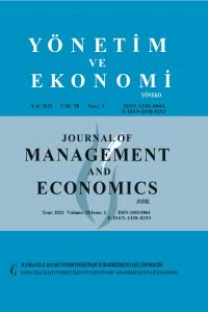Perakende Sektöründe Konjoint ve Kümeleme Analizi ile Fayda Temelli Pazar Bölümlendirme
Bu çalışmada, konjoint ve kümeleme analizi kullanılarak yapılacak fayda temelli pazar bölümlendirmenin önemi ve avantajları ayrıntılı olarak ele alınmıştır. Araştırmanın uygulama aşamasında, üniversite öğrencilerinin süpermarketlerden bekledikleri faydaların önem düzeyleri konjoint analizi ile belirlenmiş ve bu sonuçlar üzerinden kümeleme analizi gerçekleştirilmiştir. Konjoint analizi sonuçları üniversite öğrencilerinin süpermarket tercihinde en önemli faydaların sırasıyla fiyat, erişim, müşteriye yaklaşım ve ürün çeşidi olduğunu göstermiştir. Konjoint analizi sonuçları ile gerçekleştirilen kümeleme analizinde dört küme belirlenmiştir. Birinci kümede yaklaşım, ikinci kümede erişim ve ürün çeşidi, üçüncü kümede fiyat ve dördüncü kümede fiyat indirimlerinin en önemli faydalar olduğu sonucuna ulaşılmıştır. Ayrıca daha detaylı bilgi elde edebilmek için kümelerin demografik özellikleri de incelenmiştir.
Anahtar Kelimeler:
Pazar Bölümlendirme, Fayda, Konjoint Analizi, Kümeleme Analizi
Perakende Sektöründe Konjoint ve Kümeleme Analizi ile Fayda Temelli Pazar Bölümlendirme
In this study, the importance and advantages of market segmentation based on benefit by using conjoint and cluster analysis were discussed in detail. In the implementation stage of the research, the importance levels of benefits expected by university students from supermarkets were determined using conjoint analysis, and cluster analysis was performed based on these results. Results of conjoint analysis indicated that the most important benefits for supermarket preference of university students were price, access to supermarket, attitude toward customer and product variety, respectively. Four clusters were determined by cluster analysis performed with the results of conjoint analysis. It was concluded that attitude toward customer in the first cluster, access and product variety in the second cluster, price in the third cluster and price dumping in fourth cluster were the most important benefits. In addition, the demographic attributes of clusters were also investigated in order to obtain more detailed information about clusters.
Keywords:
Market Segmentation, Benefit, Conjoint Analysis, Cluster Analysis,
___
- ALTUNIŞIK, Remzi, ÖZDEMIR, Şuayip ve Ömer TORLAK (2002), Modern Pazarlama, İstanbul: Değişim Yayınları.
- ASSAEL, Henry (1993), Marketing: Principles and Strategy. Orlando: The Dryden Pres.
- BERKOWITZ, Eric. N. (2010), Essentials of Health Care Marketing, Jones & Bartlett Publishers.
- CROFT, Michael J. (1994), Market Segmentation: A Step-By-Step Guide to Profitable New Business, Routledge.
- DIBB, Sally (1998),"Market Segmentation: Strategies for Success", Marketing Intelligence & Planning, 16 (7), 394 – 406.
- GREEN, Paul E. ve V. Srinivasan (1990), "Conjoint Analysis in Marketing: New Developments with Implications for Research and Practice," Journal of Marketing, 54(4), 3-19.
- HAIR, Joseph, ANDERSON, Rolph, TATHAM, Ronald ve William BLACK (1995), Multivariate Data Analysis with Readings, London: Mcmillan Book Company.
- HALEY, Russell I. (1968) “Benefit Segmentation: A Decision-Oriented Research Tool," Journal of Marketing, 32, 30-35.
- HALLBAUER, Sven (2008), Retail Marketing and New Retail Idea - Marks & Spencer, Norderstedt/Germany: Grin Verlag.
- KOTLER, Philip; ARMSTRONG, Gary; SAUNDERS, John A. ve Veronica WONG (1999), Principles of Marketing. New Jersey: Prentice Hall Europe.
- LONIAL, Subhash, MENEZES, Dennis ve Selim ZAIM (2000), “Identifying Purchase Driving Attributes and Market Segments For PCs Using Conjoint and Cluster Analysis”, Journal of Economic and Social Research, 2 (2), 19-37.
- LOPESI, Sergio D. F., BOUBETA, Antonio R. ve Jesus V. MALLOU (2009), “Post Hoc Tourist Segmentation with Conjoint and Cluster Analysis”, PASOS, Revista de Turismo y Patrimonio Cultural, 7 (3), 491-501.
- MARSHALL, Pablo ve Eric T. BRADLOW (2002), “A Unified Approach to Conjoint Analysis Models”, Journal of The American Statistical Association, 97 (459), 674 - 682.
- MCDONALD, Malcolm ve Ian DUNBAR (2004), Market Segmentation: How to do it. How to profit from it, Elsevier.
- MCDOUGALL, Gordon. H. G. ve Terrence LEVESQU (1994), "Benefit Segmentation Using Service Quality Dimensions: An Investigation in Retail Banking", International Journal of Bank Marketing, 12 (2), 15 – 23.
- MINHAS, Raj S. ve Everett JACOBS (1996), “Benefit Segmentation by Factor Analysis: An Improved Method of Targeting Customers For financial Services”, International Journal of Bank Marketing, 14 (3), 3–13.
- NAIR, Suja R. (2009), Consumer Behaviour and Marketing Research: Text and Cases, Mumbai/India: Global Media.
- PARK, Hyejune, LIM, Chae-Mi, BHARDWAJ, Vertica ve Youn-Kyung KIM (2011),"Benefit Segmentation of TV Home Shoppers", International Journal of Retail & Distribution Management, 39(1), 7 – 24.
- PARK, Hyun-Hee ve Pauline SULLIVAN (2009),"Market Segmentation with Respect to University Students' Clothing Benefits Sought: Shopping Orientation, Clothing Attribute Evaluation, and Brand Repatronage", International Journal of Retail & Distribution Management, 37 (2), 182 – 201.
- RAO, Chatrathi P. (2006), Marketing and Multicultural Diversity, Hampshire/England: Ashgate Publishing Limited,.
- SEGAL, Madhav N. ve Ralph W. GIACOBBE (1994),"Market Segmentation and Competitive Analysis for Supermarket Retailing", International Journal of Retail & Distribution Management, 22 (1), 38 – 48.
- SHAMIR, Michal ve Jacob SHAMIR (1995) “Competing Values in Public Opinion: A Conjoint Analysis”, Political Behavior, 17 (1), 107-133.
- TATLIDİL, Hüseyin. (2009), “SPSS Uygulamalı Çok Boyutlu İstatistiksel Analiz, Teori ve Uygulama. Ekonomi Yaz Seminerleri Ders Notları”, Pamukkale üniversitesi, Denizli.
- WEINSTEIN, Art (2004), Handbook of Market Segmentation: Strategic Targeting for Business and Technology Firms, Routledge.
- WIND, Yoram (1978), “Issues and Advances in Segmentation Research”, Journal of Marketing Research, 15, 317-37.
- ISSN: 1302-0064
- Yayın Aralığı: Yılda 4 Sayı
- Yayıncı: Manisa Celal Bayar Üniversitesi İktisadi ve İdari Bilimler Fakültesi
Sayıdaki Diğer Makaleler
Silahlı Örgütler Üzerinde Çatışma Yönetimi: Silah Bıraktırma, Tasfiye ve Bütünleştirme
Karapara Aklama Aracı Olarak Yeni Bir Mali Suç: Siber-Aklama
Türkiye’de Eğitimin Finansmanı ve Ülkelerarası Bir Karşılaştırma
Ahmet TANER, Berna ERKAN, H. Ömer KÖSE
Sürdürülebilir Kentsel Gelişim Sürecinde Kompakt Kent Modelinin Analizi
Hacı Ömer KÖSE, Ahmet TANER, Berna ERKAN
Türkiye’de Katılım Bankalarının Tercih Edilme Sebepleri: Ampirik Bir Tetkik
İsmail ÖZSOY, Birol GÖRMEZ, Seden MEKİK
Perakende Sektöründe Konjoint ve Kümeleme Analizi ile Fayda Temelli Pazar Bölümlendirme
Mahremiyet Sorunlarının Önlenmesinde Mahremiyet Etki Değerlendirmesi (MED)
